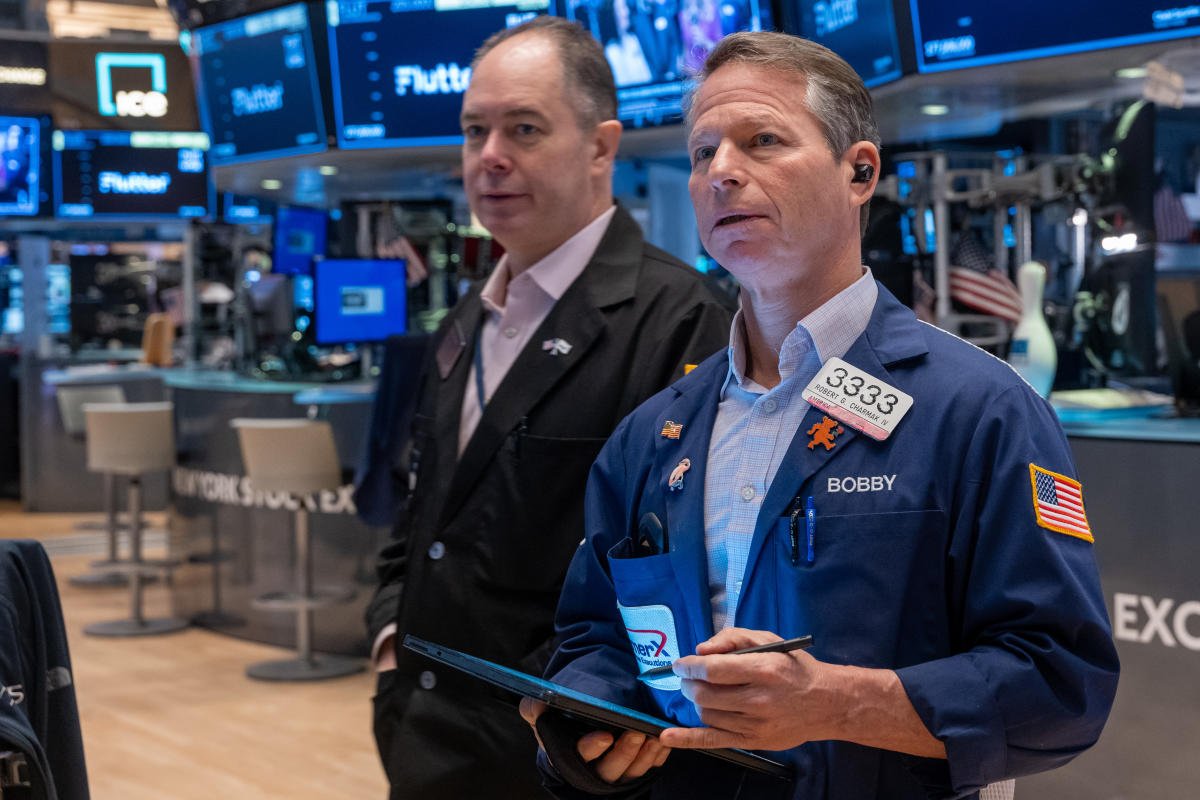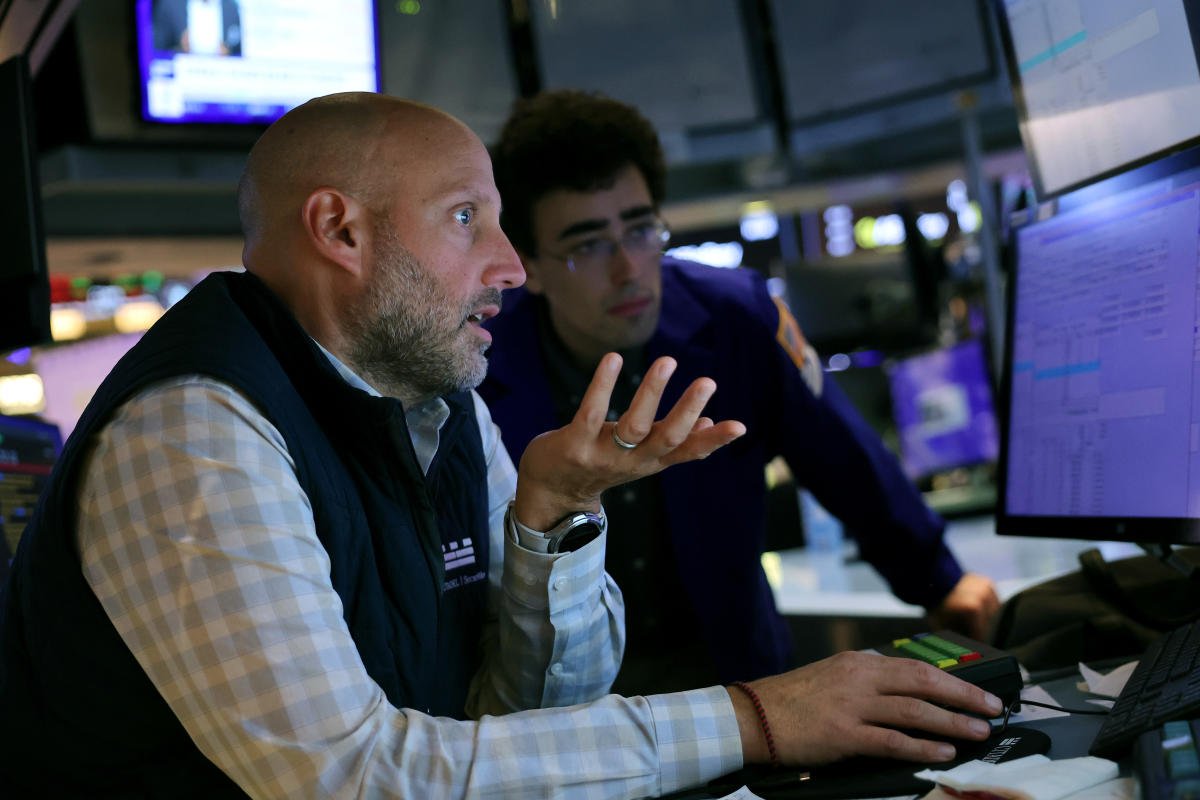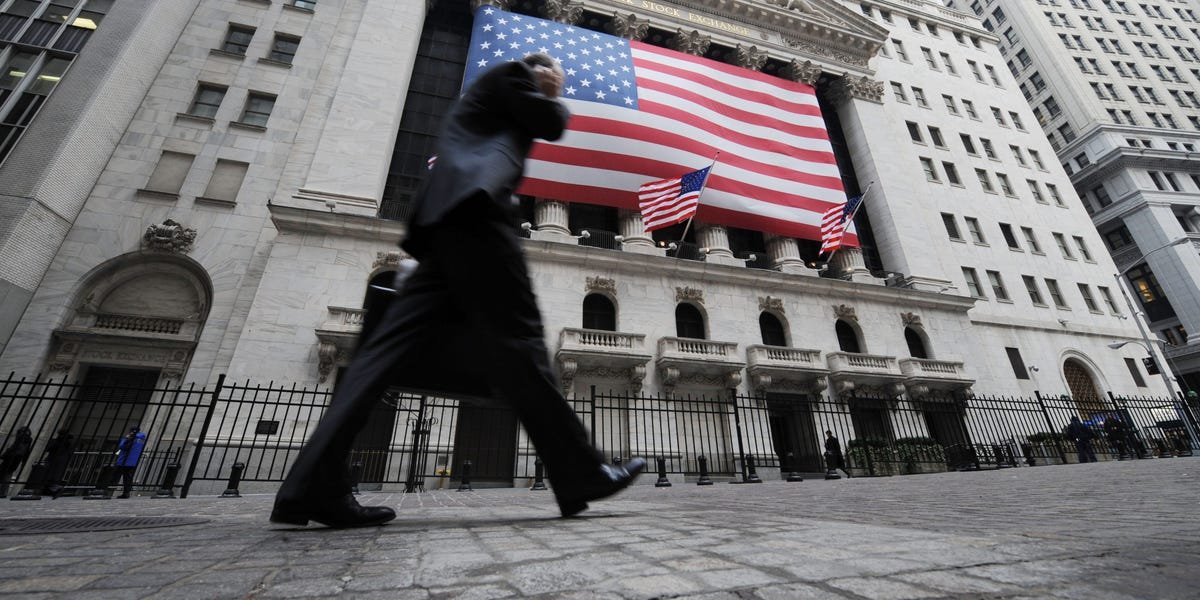US stocks popped on Wednesday, rebounding toward record highs, as investors digested a barrage of earnings results highlighted by Morgan Stanley (MS).
The Dow Jones Industrial Average (^DJI) rose nearly 350 points, or about 0.8%, to close at a record high of 43,077.70. The tech-heavy Nasdaq Composite (^IXIC) gained nearly 0.3%, while the benchmark S&P 500 (^GSPC) was up around 0.5% and closed just shy of its own record.
Meanwhile, Morgan Stanley’s quarterly report before the bell showed fresh signs of the Wall Street comeback that has boosted big bank earnings this week. Profits jumped compared to last year, thanks to a rise in dealmaking that has also lifted its peers. Shares rose nearly 7% following the release.
In commodities, gold (GC=F) rallied toward a record high as fresh tariff promises from Republican nominee Donald Trump added to uncertainty around the outcome of the tight US presidential race.
LIVE COVERAGE IS OVER13 updates
-
Utilities and Financials extend 2024 lead
Utilities (XLU) and Financials (XLF) led the S&P 500 (^GSPC) on Wednesday, extending their lead among the sectors for the year.
For the year, the Utilities sector, driven by enthusiasm surrounding interest rate cuts and energy demand to power AI servers, is up nearly 30% this year. Meanwhile, Financials, catching a recent bid off a swath of strong earnings from big banks, is up more than 26% now this year.
-
A widespread stock market rally
For a long time, the current bull market was defined as a few stocks driving the major averages higher.
Not only is that no longer true, but we’re actually seeing one of the most widespread rallies to new all-time highs of the current rally. During Tuesday’s trading session over 20% of stocks in the S&P 500 traded at a 52-week high, while no stocks traded at a 52-week low, per Bespoke Investment Group.
That marked the strongest net percentage of stocks hitting new 52-week highs in a single trading session since March 21. And omitting that one day in March, it was the highest since May 2021.
-
Oil could fall to $25 per barrel by 2050 if net zero emissions goals met, IEA says
The world is on its way toward cheaper energy as clean technologies grow to meet growing electricity demand, leaving behind an oversupply of oil and gas, according to a new report from the International Energy Agency (IEA).
Under its primary scenario, the IEA, which advocates for green technologies, predicts clean energy will meet “virtually all” growth in energy demand between 2023 and 2035, leading to a peak in demand for all three fossil fuels before 2030.
That translates to oil import prices of about $79 per barrel in 2030, higher than where fossil fuel is currently trading. But under the scenario where the world achieves its net zero emissions and limits global warming, IEA sees oil prices falling to $25 per barrel by 2050.
Read more here.
-
Will another round of price hikes hit Netflix users?
Netflix (NFLX) is set to report its fiscal third quarter earnings on Thursday after market close — and analysts are looking ahead to another possible round of price hikes.
Netflix last raised the price of its Standard plan in January 2022, upping the monthly cost to $15.49 from $13.99. It also raised the price of its Premium tier by $2 to $19.99 a month at the same time; the company again raised the cost of that plan in October to $22.99.
The company has yet to raise the price of its ad-supported offering, introduced less than two years ago, which remains one of the cheapest ad plans among all of the major streaming players at $6.99 a month.
“Given Netflix’s low cost per viewed hour, we see scope for the firm to raise US prices by 12% in 2025,” Citi analyst Jason Bazinet said in a note to clients.
On average, US consumers subscribe to four streaming services and spend about $61 per month, according to the latest Digital Media Trends report from Deloitte. Retaining loyal subscribers over time is a challenge due to consumers churning out of, or canceling, their subscription plans.
Read more about what Wall Street expects from the streaming giant here.
-
Investors eye key retail sales report on Thursday
The September retail sales report is slated for release at 8:30 a.m. ET.
Consensus expects sales rose 0.3% in the month, up from the 0.1% increase seen in August, per Bloomberg data. The data comes at a critical time in the economic narrative as a blowout September jobs report has sparked debate over if the US economy is actually cooling or starting to show signs of a reacceleration.
Bank of America US economist Stephen Juneau believes the report could show signs of the latter.
“This week’s September retail sales report should continue the run of hot data,” Juneau wrote in a Monday note to clients. “Should our forecast prove correct, the narrative may shift further toward “no landing” or even re-acceleration.”
Importantly, though, Bank of America’s equity strategy team doesn’t believe markets beginning to price in a “no landing,” where economic growth remains resilient or reaccelerates while inflation doesn’t fall as rapidly to the Fed’s 2% goal, would necessarily be bad for stocks.
“‘No landing’ is bullish for stocks, in our view, as long as inflation doesn’t flare up,” Bank of America US and Canada equity strategist Ohsung Kwon wrote Monday. “In a contained inflation environment, the relationship between rates and stocks should be positive (i.e. good news is good news). The Fed cutting into an accelerating EPS environment suggests cyclicals should outperform defensives.”
-
Novavax shares tank after vaccines for flu, COVID put on hold
Novavax (NVAX) shares were down more than 17% on Wednesday after US regulators placed the company’s experimental flu and COVID combination vaccines on hold.
The moves comes after a study volunteer for the combination vaccine developed a serious nerve disorder.
-
Utilities, Financials lead S&P 500 into positive territory
Just after 12:30 p.m. ET, the Dow Jones Industrial Average (^DJI) rose more roughly 250 points, or 0.6%. The tech-heavy Nasdaq Composite (^IXIC) slipped just below the flat line, while the benchmark S&P 500 (^GSPC) was up 0.2%.
Utilities (XLU) and Financials (XLF) led the action in the S&P 500, both rising more than 1%.
Source: Yahoo Finance -
Russell 2000 pacing for highest close since November 2021
The small-cap Russell 2000 (^RUT) index is up more than 1.5% on Wednesday, far outpacing the gains of the three major indexes and closing in on its 52-week high of 2,300.
If the Russell closes at its current levels, it will mark the highest close for the index since November 2021.
Small caps have been one of the most highly debated trades on Wall Street in 2024. Given the sector’s higher exposure to refinancing risk, strategists have argued that lower rates will benefit the group. That thesis, combined with evidence that the US economy continues to track for solid growth, has once again built the case for an allocation to small caps, according to Wall Street strategists.
Morgan Stanley chief investment officer Mike Wilson recently moved to a “neutral” on allocation to small versus large caps following the Federal Reserve’s half-percentage-point interest rate cut in September.
“For us to get outright bullish on Small caps overall, leading macro indicators would likely need to show that a clear acceleration in growth is coming,” Wilson wrote in a note to clients on Tuesday. “For now, we’re focused on idiosyncratic opportunities within the small cap space.”
He added, “Valuation is relatively cheap for small caps, while earnings are set to improve. To some extent, this has been the Small cap index mantra for nearly two years, but after consecutive years of earnings contraction, the consensus is more optimistic on earnings expansion ahead.”
-
Airlines hit a 52-week high
The US global Jets ETF (JETS) rose around 3% to hit a fresh 52-week high on Wednesday. The ETF’s top holdings include major carriers such as United Airlines (UAL), Delta (DAL), American Airlines (AAL), and Southwest (LUV).
The rally in airlines follows a better-than-expected earnings report from United after the bell on Tuesday. The carrier posted adjusted earnings of $3.33 per share for the third quarter, topping Wall Street’s estimates for $3.07.
United also announced a program to repurchase up to $1.5 billion in shares. Its stock rose more than 9% in morning trade on Wednesday.
-
Amazon to explore nuclear development with Dominion Energy
Amazon (AMZN) and Dominion Energy (D) said on Wednesday that they have signed an agreement to advance the development of nuclear Small Modular Reactors in Virginia.
The partnership is part of Amazon Web Services’ investment of over $500 million in nuclear power, CNBC reported. Amazon is the latest big tech company to explore nuclear energy to power its artificial intelligence plans. Both Alphabet (GOOGL, GOOG) and Microsoft (MSFT) have laid out nuclear strategies.
Shares of Dominion Energy spiked more than 4% on the news.
-
Morgan Stanley stock jumps as its investment banking surges
Morgan Stanley (MS) stock jumped 4% at the open after the company reported large year-over-year increases across a variety of metrics in its third quarter earnings release.
Yahoo Finance’s David Hollerith reports:
Fees from investment banking jumped 56% from a year ago, the largest leap among big banks, to nearly $1.4 billion.
The pick-up in investment banking and an increase in trading helped Morgan Stanley push its net profit up by 32% from a year earlier, to $3.2 billion.
The results cement a broad rebound across the Wall Street operations of the country’s biggest banks. Investment banking fees and equity trading revenue also jumped at JPMorgan Chase (JPM), Wells Fargo (WFC), Goldman Sachs (GS), Bank of America (BAC), and Citigroup (C).
-
Stocks flat at the open
US stocks were muted on Wednesday as investors digested results from Morgan Stanley (MS) and others to potentially power a rebound to record highs after an ASML-fueled (ASML) slide.
The Dow Jones Industrial Average (^DJI), the benchmark S&P 500 (^GSPC), and the tech-heavy Nasdaq Composite (^IXIC) were all near flat at the open.
-
Good morning. Here’s what’s happening today.




















